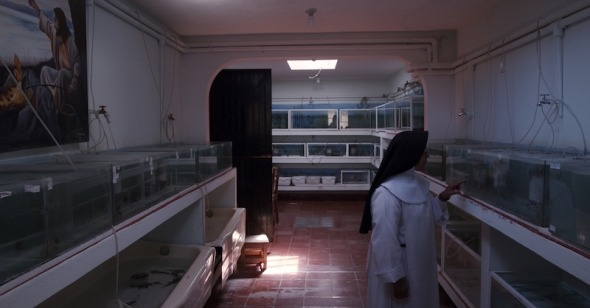Take It All
By Nicholas Russell
A Common Sequence
Dir. Mary Helena Clark and Mike Gibisser, U.S., no distributor
A Common Sequence plays Saturday, March 18 at Museum of the Moving Image's 2023 First Look festival.
The film opens with a glimpse of the future, though the audience doesn’t know this yet. Upon my first viewing of A Common Sequence, I mistook its opening images for still lifes, darkened tableaux of apple trees, leaves and branches subtly nodding in the breeze, an empty orchard on an overcast day. By the film’s conclusion, the orchard will have been transformed into a kind of horrible laboratory, a site of human intervention and exploitation, a harbinger of technologies masked as conveniences.
Nominally, A Common Sequence is a documentary, though, threading together meditations on colonialism, environmental degradation, capitalism, labor and immigration, machine learning and AI, DNA harvesting and genomic manipulation, the film, directed by Mary Helena Clark and Mike Gibisser, adopts a nonlinear, almost impressionistic approach. History, in the filmmakers’ hands, takes the shape of a tree, not dissimilar from the apple trees that begin the narrative, such as it is, forking in all directions, but anchored by a unifying thematic trunk: extraction.
The first people introduced in A Common Sequence are seen only through the dizzying bob of headlamps cutting through early morning dark. Fishermen in Pátzcuaro, Mexico, are venturing out onto the lake that has been the generational lifeblood of the indigenous P’urépecha, in search of the once-abundant, now-scarce achoque, an endangered species of axolotl. Like many of the film’s sequences, Clark and Gibisser hold on a static shot, in this case the fishermen in their boat, reeling in a net and sorting through its wriggling contents while dogs splash nearby in the water, waiting for an errant fish to be thrown their way. An achoque, the audience learns from one of the fishermen, hasn’t been found in the lake in ten years. A Mexican president, as a gift to his wife, planted water lilies in the lake, which choked the life out of the native flora. To curb the lilies’ spread, carp were introduced in the belief that the fish would eat the flower. Instead, the carp multiplied, cutting off the food supply for the lake’s trout, whitefish, and, finally, the achoque.
Historically, the achoque’s various uses, as sustenance and medicine, have been enjoyed by both the P’urépecha and a local convent, whose nuns extract a dark syrup from the skin and sell it to keep the convent operational. With the achoque now seemingly extinct, the convent has had to resort to creating its own artificial sanctuary to stay afloat, while the fishermen try to restore the lake to its previously untampered state. From this thread, A Common Sequence branches outward, utilizing philosophical and academic texts as narration to give crucial, if sparse context for how the film’s various pieces fit together. With their film’s formal rhythms and wide-angle perspective, in the use of its ambient, droning soundtrack, and the sometimes slideshow-like presentation of graphs, x-rays, data sets, documents, and photographs, Clark and Gibisser are less interested in linearity than they are in crafting an overarching, often terrifying web of connections and implications. After Pátzcuaro, the film follows some of its inhabitants to an apple orchard in the city of Prosser in Washington State, where migrant workers learn to pick apples, and where, at the nearby Washington State University, students and scientists are constructing robots to effectively eradicate the workers’ labor. At the same time, the audience learns about the process of patenting fruits, via the Borgesian method of splicing two species together to create a product that cannot occur in nature, and therefore can be copyrighted as a human invention. This is similar to how—as the audience learns from a P’urépecha-descended biomedical researcher—scientists once patented a strand of human DNA before American courts reversed the decision.
For Clark and Gibisser, the twinned ambitions of innovation and discovery mask a darker, more hubristic endeavor to more effectively extract resources from the Earth, to own and hoard intellectual property, to capitalize on this ownership and extend the now-ephemeral boundaries of empire. As it continues, A Common Sequence becomes increasingly untethered from its documentary auspices, offering flights of surrealist imagery: a never-setting sun, the lightening and darkening of a given image, like consciousness winking in and out. The film’s prevailing sense isn’t that everything we have done as a species, to each other, to the environment, has been in the name of greed or conquest, but rather that everything is connected and consequential. As the film returns to the fishermen of Pátzcuaro, after Clark and Gibisser have strung together an ever-intricate map of causes and effects, one is hard-pressed to refute the fact that no action occurs in physical or ethical isolation. It’s a reality too often papered over and increasingly hidden by recalcitrant politicians and ignorant masses, and as this kaleidoscopic film demonstrates, should not be taken lightly.
